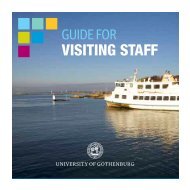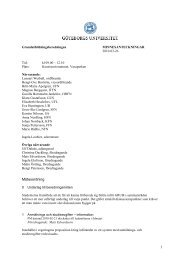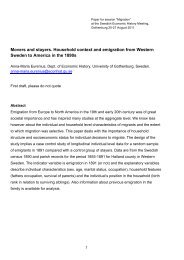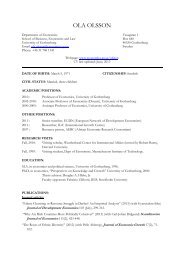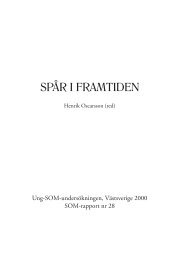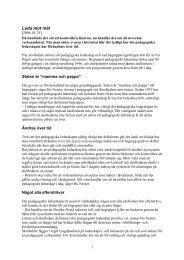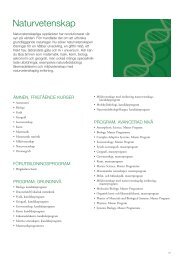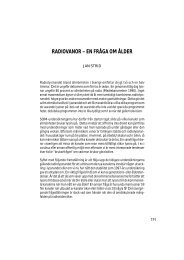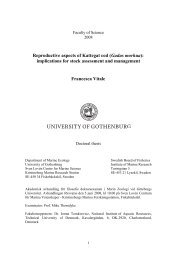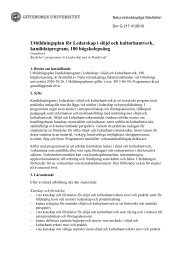The History of - Göteborgs universitet
The History of - Göteborgs universitet
The History of - Göteborgs universitet
You also want an ePaper? Increase the reach of your titles
YUMPU automatically turns print PDFs into web optimized ePapers that Google loves.
1939 World War II began.<br />
1941 the actress Maria Schildknecht started a school that preceded the Academy<br />
<strong>of</strong> Music and Drama. People started using penicillin in the same year.<br />
From Medicine to Public Health<br />
<strong>The</strong> Sahlgrenska Academy at the University <strong>of</strong> Gothenburg<br />
was established in 2001, but its history dates<br />
back to the 18th century.<br />
<strong>The</strong> first medical college in Gothenburg was<br />
founded in 1949.<br />
Five years later it merged with Gothenburg University<br />
College, forming the University <strong>of</strong> Gothenburg.<br />
In 1967 the University <strong>of</strong> Gothenburg gained a<br />
faculty <strong>of</strong> odontology. A new large building, ‘Kopparborgen’<br />
(lit. the copper fort), was erected on – or was<br />
rather partly built into – the Medicinareberget hill.<br />
In 1983 the Faculty risked being closed down as<br />
the need for dentists had dwindled. Researchers, students<br />
and staff responded with a successful campaign<br />
that included demonstrations and letters to members<br />
<strong>of</strong> Parliament.<br />
In 1998 the University College <strong>of</strong> Health Sciences<br />
had joined the University <strong>of</strong> Gothenburg, and the<br />
faculty <strong>of</strong> health sciences was established in 2001.<br />
Intensive preparations in the 1990s led to the formation<br />
<strong>of</strong> the Salgrenska Academy as a University<br />
unit for health sciences.<br />
It made good sense to name this new part <strong>of</strong> the<br />
University after the merchant Niclas Sahlgren, who<br />
bequeathed money to the construction in the 1700s.<br />
In 2001 the Sahlgrenska Academy was inaugurated<br />
by its own Nobel Prize winner in medicine<br />
Arvid Carlsson. This marked the beginning <strong>of</strong> a new<br />
era for the education and research within the health<br />
sciences in Gothenburg. <strong>The</strong> academy is founded on<br />
the idea <strong>of</strong> working to prevent and cure illness in<br />
present and future generations while focusing on the<br />
individual. Concretely this meant that the faculties<br />
<strong>of</strong> odontology and health sciences joined forces. <strong>The</strong><br />
cooperation between the University and the healthcare<br />
sector has been and is extensive. A majority <strong>of</strong><br />
the students at the Academy conduct parts <strong>of</strong> their<br />
studies at the Sahlgrenska University Hospital, and<br />
many staff members work both in the healthcare<br />
field, <strong>of</strong>ten as doctors, and as researchers/teachers at<br />
the Sahlgrenska Academy.<br />
On the left side <strong>of</strong> the road from Linnéplatsen<br />
to the Sahlgrenska Hospital is Gothenburg’s former<br />
children’s hospital, today the headquarters for education<br />
and research within the health sciences.<br />
Sahlgrenska Hospital and the Medicinareberget<br />
hill are divided by a busy road, yet the organisations<br />
were connected with a glass skywalk in 2004. <strong>The</strong><br />
University has facilities inside the hospital, but also<br />
at Östra Hospital and Mölndal Hospital.<br />
Doctor, dentists, pharmacists, different types <strong>of</strong><br />
16 <strong>The</strong> <strong>History</strong> <strong>of</strong> the University <strong>of</strong> Gothenburg



